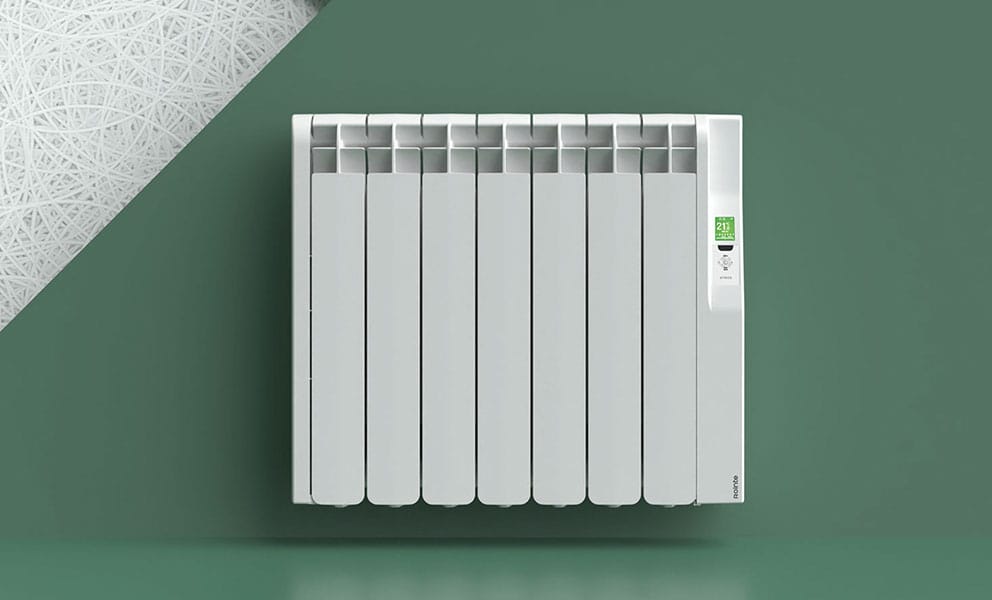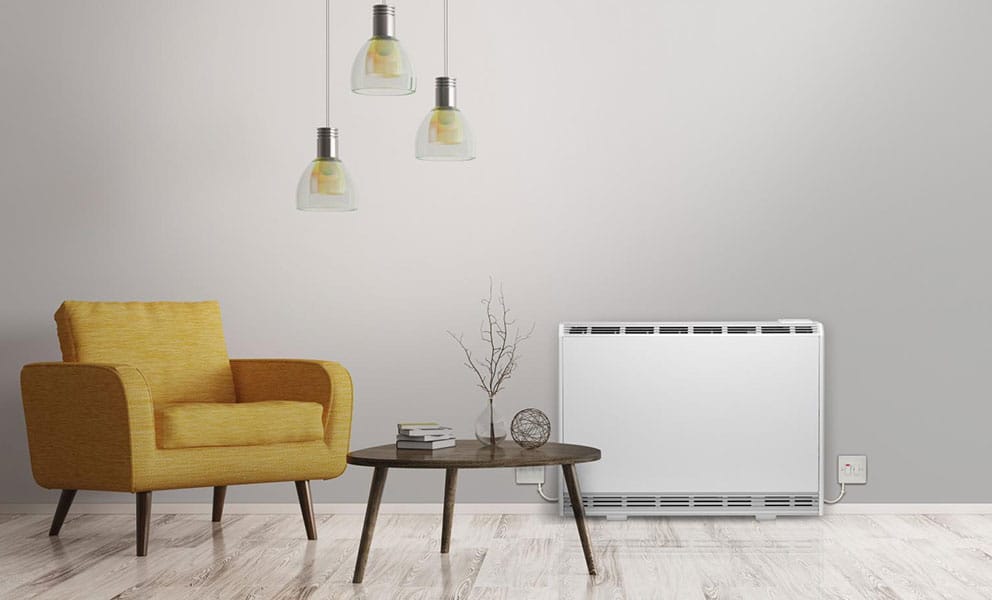
In this guide, we’ll run through everything you need to know about electric radiators, including the different types available, the best models in 2023, and what to consider when you’re shopping around.
First things first, it’s important to understand the difference between modern electric radiators and traditional electric heaters. The latter has built up a bad reputation for being ineffective and expensive to run, which is unfairly attributed to electric radiators more broadly.
Electric heaters are portable appliances you plug in. Often similar in appearance to a wall-mounted radiator, they’re handy when you don’t have a permanent source of heat. That could be a temporary space like a portacabin, an emergency backup if your boiler is broken or a way to heat your conservatory or garden room.
When you say “electric radiators”, many people think of these portable appliances. That’s because central heating radiators are the most common primary heating source for UK homes and businesses.
However, wall-mounted electric radiators are gaining traction for a number of reasons – more on this below. Instead of being a temporary measure, these radiators are wall-mounted to replace central heating altogether.
Why are lots of people replacing central heating radiators with their electric counterparts? Let’s take a look…
With no boiler, electric radiators don’t need to be serviced annually like central heating. They’re quick and simple to install with extended warranties available and no risk of carbon monoxide whatsoever.
Because they’re not fuelled by a central boiler, electric radiators make it much easier to heat parts of your home separately. That could be the living room if you’re spending the evening there, the home office if you’re working remotely or just the upstairs at the start of the day before work and school.
All of the energy used by electric radiators is converted into heat. That’s in stark contrast to gas boilers (and radiators), which can be anywhere from 70-90% in efficiency. So, using the best electric radiators means you can save energy, reduce your bills and cut your carbon footprint.
If you want to use renewable energy for conventional radiators, you’re limited to a heat pump or an electric boiler powered by solar panels. On the other hand, electric radiators make it easy to go renewable as they can use energy from solar panels and batteries.
Because they’re powered by electricity, they’re also more renewable even for homes without solar panels. Renewables already account for over 40% of the UK’s electricity, with continued efforts to increase this proportion.
There’s a common misconception that electric radiators are more expensive to run. It’s true that electricity costs more than gas per unit. However, all of the factors above contribute to make electric radiators one of the best ways to heat your home without breaking the bank.
When searching for the best electric radiators, you’ll probably come across the terms “oil-filled” and “oil-free”. This simply refers to how they heat up.
For oil-filled electric radiators, electricity is used to heat the oil, allowing the radiator to heat your space through convection and radiation. With oil-free electric radiators, the only difference is that oil is replaced with a different thermal component such as aluminium or stone.
Oil-free electric radiators are known to heat up a little quicker. They can also be longer lasting because there’s no need for a pressurised container for oil, which can rupture and leak over time.
The majority of wall-mounted radiators are fitted horizontally. Originally, that was because radiators were placed under windows to avoid taking up wall space in other parts of the room. After that, it simply became conventional.
In recent years, we’ve seen vertical models grow in popularity. Many people like them because they take up less horizontal wall space, making it easier to position large items of furniture. Others simply prefer the look.
You can find electric radiators in both horizontal and vertical designs. The orientation itself doesn’t have an impact on heat output, so you simply need to decide what fits best or looks best for your home – or different rooms.
Arguably the most critical element when finding the best electric radiators for your home is their size. While physical dimensions are part of this, size refers to their capacity in terms of wattage. While it might seem like a simple choice, there are a number of factors that can affect the wattage requirements of each room:
There are a wide range of control options and energy-saving features available for electric radiators. It’s good to know what’s available, so you can make the right choice for your home. Some features include:
While it probably shouldn’t be your first concern, style is definitely another influence when choosing electric radiators. As a modern alternative to central heating, they’re available in a vast array of styles.
Colours range from classic white and monochrome grey or black to unique effects like copper and brass radiators. You can also choose between different designs, such as traditional columns or sleek, slimline panels.
One final consideration is the warranty that comes with your new electric radiators. Quite simply, this is how long you’ll be protected against any defects, with repairs or replacements covered by the manufacturer.
Electric radiators typically have different warranties for the body versus electronics. You can expect a warranty of 5-10 years for the body, with 1-5 years for electrical components.
One of the most important factors in your search for the best electric radiators is the manufacturer. Your choice of manufacturer will ultimately determine how well your radiators perform and how long they last.
It’s a bit like searching for the right car – you might find a Dacia that ticks all the boxes in terms of style and features, but its BMW counterpart will always perform better on the road. Of course, you also have to consider costs, given that a BMW would be more than twice the cost of a Dacia!
Going back to radiators, here are some of the leading brands available in the UK:
Which comes out on top? At Somerset Heating, we believe Rointe electric radiators are the best available for UK homes and businesses. They provide everything you need with long-term performance, ease of use and great features for energy efficiency.
Rointe has a dedicated app that works on both mobile devices and PCs, so you can control all your radiators and manage consumption. There’s also a choice of remote controls to adjust temperatures, set schedules and create programmes.
Above all else, however, it comes down to quality and choice. From vertical to horizontal and oil-filled to stone core, Rointe offers a wide range of electric radiators which are built to last with a guarantee of 10 years on the radiator body and 3 years for electrics.
Sygma is a range of slim, affordable electric radiators from Rointe. They offer 24/7 programming with great energy efficiency. Choose from as little as three heating elements up to 15 with wattage ranging from 300-1,650W.
Similarly, D Series radiators come with a choice of 3-15 elements, which range from 330-1,600W. However, these electric radiators benefit from Wi-Fi connectivity. This makes them compatible with home automation tech, smartphone apps and smart voice control through Google and Alexa.
Finally, there’s Olympia. This is Rointe’s oil-free range, which uses a natural stone core for extra efficiency. It absorbs heat faster, radiates it quicker, and holds it for longer. There’s a choice of between 3-11 heating elements with total wattage from 500W to 1,750W.
The cost of your electric radiators depends on two main factors – the type of radiators you need and the size of the installation.
Firstly, by type of radiators, we mean the manufacturer, model and features you’ve chosen. It goes without saying that a top-of-the-range Wi-Fi-enabled, oil-free electric radiator from a top brand will cost more than the most basic model out there.
Then there’s the size. As well as the number of rooms and radiators, the size of individual radiators will affect the price. That can be anything upwards of three heating elements (around 300W) to heat a four-square-metre room.
To give you a rough idea, the smallest electric radiators cost around £200-300 per unit. However, this is before the cost of labour, which brings us onto…
It’s no use getting the best electric radiators if you don’t have the right team installing them. Here’s why…
While we hope this guide can help you along the way, a good contractor will be able to advise on the right radiators for your needs – whether that’s room size, smart features or just the best fit for your budget.
Whether they’re hard-wired or plugged into a socket, electric radiator installation requires the right skill, experience and expertise. The best installers will ensure your radiators look great, work perfectly and stand the test of time.
One of the big selling points of electric radiators is the control you’ll have over temperature, timings and zones. Choosing a knowledgeable contractor will give you the best possible understanding of programming from those who know it like the back of their hand.
By choosing a manufacturer-approved contractor, you’ll make sure your warranty is kept intact too. That will give you complete peace of mind that your electric radiators will work as expected and there will be no unexpected costs.
If you want the best electric radiators for your home, Somerset Heating is on hand to help. We’re certified by Rointe as smart heating installers, meaning we have the knowledge and experience to recommend the right products for your need, install them flawlessly and explain how everything works clearly.
To get started, simply arrange a home visit where we can assess your home, discuss your requirements and answer any questions you have. From there, you’ll get a quote that covers supply and installation with no obligation whatsoever.


"*" indicates required fields